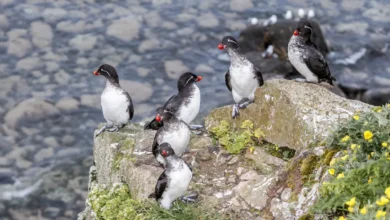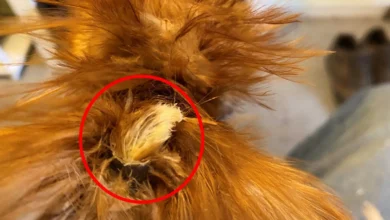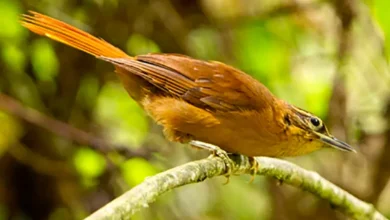Killer Chickadees and Other Strange Bird Behavior
Terrifying Chickadees and Other Odd Bird Behavior
Just in time for Halloween comes a strange and gruesome tale from a dark cave deep in the forests of Eastern Europe. The killer is an unlikely one: An ordinarily friendly little bird called the great tit that is a close relative of, and a dead-ringer for, the North American chickadee.

Tiny, Cute Birds Prey On Bats
Researchers from Europe’s Max Planck Institute for Ornithology report that the great tit (Parus major), the Old World’s answer to America’s chickadee, has a previously unsuspected dark side to its nature. During the depths of winter when food is in short supply, tits enter caves used by hibernating bats, kill the bats by pecking their heads open, then drag them out into the sunlight and eat them.
Tits and chickadees are diminutive black, grey and white birds that grow to about 14cm (5.5 inches). They usually feed on insects, seeds and berries, and with patience, they can be trained to perch on a person’s hand and take a sunflower seed. But the Max Planck Institute’s observations throughout two winters outside of a bat cave in Hungary show that when times are tough, the birds will do what they have to to survive.
The bat species the birds have been feeding on is the common pipistrelle (Pipistrellus pipistrellus) which attains a length of about 2 inches (4.5cm), with a wingspan of less than 9 inches (19cm). According to the researchers, the chickadees seem to locate their victims in the gloom of the hibernation cave by homing in on the squeaks and other noises they make. The scientists were able to attract bat-eating tits by playing recordings of pipistrelle vocalizations.
But the researchers added that tits apparently seek out bats only when other sources of food are hard to come by and, given a choice, they seem to prefer eating almost anything else. When bird feeders were place near the bat caves, the birds quit going into the caves and ate the seeds instead.
Ugly Mates Make Female Zebra Finches Lay Larger Eggs

A slightly less grim, but no less fascinating, finding from the laboratories at the Max Planck Institute for Ornithology is that when female zebra finches have no reproductive option but to mate with an ugly male, they tend to lay larger-than-normal eggs. The researchers hypothesize that the females are compensating for their mate’s lack of genetic fitness for fatherhood by giving their offspring an egg containing extra nutrients and more room to grow.
The females of many other species of birds do just the opposite: They lay a smaller egg when they perceive the father to be a loser, and a larger one when he’s a hunk. And that would seem to make more sense, genetically speaking, since offspring that are likely to be stronger and healthier and look more attractive to future potential mates make for a better investment of the female’s resources and energy. But since zebra finches mate for life, she’s got to do the best she can with the genes at hand . . .
In preparing for their experiment, it was easy for the scientists to tell which male zebra finches were viewed as ugly (genetically inferior) by the other finches: They were the ones that females repeatedly rejected as mates. In other words, they were the guys who were always going home alone at the end of the evening. The researchers then placed each of these previously luckless males into a breeding cage with a female and no other potential mates for her to choose from. After the female finally realized she was stuck with the video-game-playing, stained T-shirt-wearing genetic underachiever, she would invariably sigh, shrug and start straining to produce the biggest eggs she possibly could.
The zebra finch, (Taenopygia guttata) is a native of central Australia, and a favorite of pet owners and genetic researchers alike.
The Albatross And The Orca
Tis one has all the makings of a children’s book: A lonely seabird, flying over the featureless ocean, finally spots a killer whale far below and begins to follow her wherever she goes. That was the scene that an albatross cam—a time-lapse camera attached to a black-browed albatross (Thalassarche melanopyrys)—seemed to reveal to a Japanese and British research team working in the Falkland Islands off the far-southeastern coast of South America.
The camera appeared to show that other birds were following the whale as well, and additional instruments attached to the camera-carrying albatross indicated that the bird was probably diving near the whale.

But scientists don’t think the birds were following the Southern Ocean’s largest predator because they were looking for company. More likely, they were hoping to dine on her table scraps after she made a kill. (Killer whales, or orcas, feed on seals, penguins, other whales, and fish.) In fact, other types of seabirds frequently follow ocean predators and schools of predatory fish in hopes of getting some of the leftovers, and that’s what was probably happening between the albatross and the orca.
In spite of the fact that the black-browed albatross lives in remote, sub-Antarctic areas, it is listed by the IUCN as Endangered. Conservationists think its numbers have been declining because the birds are frequently killed when they go after strings of baited hooks drawn behind long-line commercial fishing vessels.



